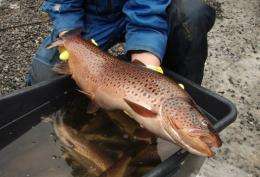Conservation of genetic structure in lake salmonids affected by hydropower regulation, release of fish and hybrids

The negative effects of releasing fish and the possible fragmentation of natural fish stocks in connection with hydropower regulations may be fewer than at first feared.
Jens Wollebæk's doctoral thesis shows that the genetic structure of established stocks of wild trout and charr is only affected to a small extent by human intervention in the study area.
Released fish often have a different genetic structure to that of wild fish and can pose a threat to the natural, genetic structure of wild fish stocks. By means of DNA analyses, Wollebæk has studied genetic variation in trout and charr living in two mountain reservoirs in the county of Buskerud, Norway. Since 1919, the ecosystem has been greatly affected by hydropower regulations and the subsequent release of large numbers of trout. In addition, an unintended colonisation of charr and minnows has occurred.
Released trout accounted for nearly 30% of the sexually mature fish in the reservoirs and it was assumed that the prolonged use of non-indigenous and previously released fish in hatcheries posed a risk to the genetic integrity of wild fish. However, it appears that wild fish maintain their natural, genetic structure, principally due to the high mortality of indigenous and released hybrids and to the fact that released fish do not migrate when spawning. Wollebæk's research shows that the genetic material of natural fish stocks is most affected by natural gene flow between nearby, wild substocks of trout within comparable habitats in the reservoirs studied.
Variations in water flow impinge on the life history strategy of the trout and charr to a greater extent than migration barriers introduced by humans. Nevertheless, the reproductive behavior of trout and charr has changed since the introduction of charr and minnows. Wollebæk's thesis reveals the rate and degree of change in the genetic structure of both trout and charr.
Indigenous stocks of lake trout and growing, reproductive barriers between populations of charr established in stable habitats during the last century point to the capacity of salmonids to survive and adapt to changing environmental conditions. Wollebæk's doctoral thesis shows how genetic and ecological variation builds a foundation for selection and is a decisive factor in the establishment of alien species and the preservation of reproductive barriers. For this reason, both genetic and ecological criteria should be taken into account when managing fish stocks and regulating watercourses for hydropower purposes.
Cand.scient. Jens Wollebæk defended his doctoral thesis on 27th June 2011 at The Norwegian School of Veterinary Science. The thesis is entitled: ”Gene flow resilience in alpine lake salmonids: a conservation perspective.”
Provided by Norwegian School of Veterinary Science
















